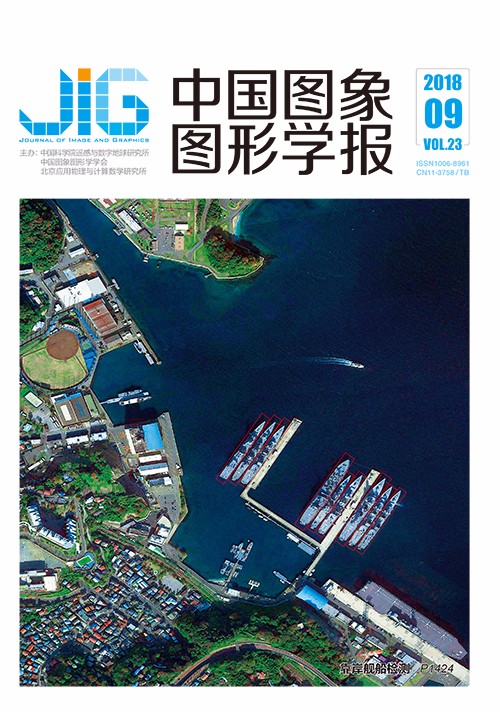
高分辨率遥感图像投影分析的靠岸舰船检测
张磊1, 洪星1, 王岳环1,2, 周斌3(1.华中科技大学自动化学院, 武汉 430074;2.多谱信息处理技术国家级重点实验室, 武汉 430074;3.北京航天自动控制研究所, 北京 100854) 摘 要
目的 高分辨率遥感图像中,靠岸舰船检测有着广泛的应用前景,其主要难点在于舰船与港口陆地在空间上紧邻,在颜色和纹理特征上相似,舰船与港口陆地难以分割。针对这种情况,利用港口岸线平直的几何特点和靠岸舰船多为舷靠的停泊特点,提出一种基于投影分析的靠岸舰船检测方法。方法 首先,对原始图像进行预处理,利用K-means聚类算法与区域生长算法相结合的方式得到海陆分割图像,利用Sobel算子与Otsu分割结合的方式获取边缘图像;然后,通过改进的Hough变换提取直线特征,结合港岸几何特性定位港口岸线;再将海陆分割后的二值图像向沿岸线和垂直岸线两个方向进行投影,根据沿岸线方向投影形态确定和分离并靠舰船,根据垂直岸线方向的投影形态定位舰船目标;最后,利用舰船尺寸、长宽比、最小外接矩形占空比特征去除虚警。结果 在15个港口场景不同分辨率的遥感图像测试集上,本文方法整体检测率达到85.4%,虚警率达17.2%;限定分辨率范围在24 m的情形下,检测率提高到93.5%,虚警率降低至5.3%。结论 本文方法简单有效,无需港口先验信息,适用于多尺度和多方向的靠岸舰船目标检测任务,对不同类型舰船形态差异具有鲁棒性,且能够分离并靠舰船。
关键词
Inshore ship detection in high-resolution remote sensing image using projection analysis
Zhang Lei1, Hong Xing1, Wang Yuehuan1,2, Zhou Bin3(1.School of Automation, Huazhong University of Science and Technology, Wuhan 430074, China;2.National Key Lab of Science and Technology on Muti-spectral Information Processing, Wuhan 430074, China;3.Beijing Aerospace Automatic Control Institute, Beijing 100854, China) Abstract
Objective In high-resolution remote sensing images, inshore ship detection has broad application prospects, such as ocean surveillance, fisheries management, and military reconnaissance. However, unlike the ship detection under pure sea background, inshore ship detection is much more challenging, considering the complex background of the port. The main difficulty of inshore ship detection is that the ship and the dock are adjacent in space and similar in color and texture features, thereby introducing difficulties in distinguishing them. Effective methods for this task are scarce. The existing methods can be mainly into three types. The first is based on template matching but prior geographical information of the port is needed, which is often difficult to obtain. The second type is based on the ship contour method, in which the robustness is low and detecting side-by-side ships is difficult. The third type is based on local features of the ship, which often assume that the ship has a V-shaped bow and is powerless to other ships. Other than the existing methods, a method for inshore ship detection using projection analysis is proposed in this paper. Our method is based on the observation that the shoreline of a dock is typically straight and inshore ships are usually anchored along the ship's rail. Method First, the original image is preprocessed by two sibling approaches:one that segments the sea and land and another that extracts edges. For sea-land segmentation, the K-means clustering algorithm and region-growing algorithm are combined to improve the segmentation quality, which is significant for our method. Meanwhile, the original image is processed to a gradient image by Sobel operator, and then the gradient image is segmented to an edge image with the Otsu algorithm. Second, an improved Hough transform is conducted on the edge image to extract the straight lines, among which are dock shorelines. To remove interference lines, we assume that all extracted lines of dock shorelines should only lie on the border of water. Then, we start to search for ships on both sides of the located dock shorelines. Taking one dock shoreline as an example, we project the sea-land segmentation image perpendicular to the dock shoreline direction and obtain a projection curve. If a ship is anchored along the dock shoreline, the projection curve shape is convex. Otherwise, the curve shape is flat. Furthermore, we can locate the ship with a bounding box by analyzing the curve shape conveniently. To separate side-by-side ships, we conduct another projection in the dock shoreline direction and separate these ships by analyzing the peak and valley of the projection curve. Finally, we remove false alarms using features of ship size, aspect ratio, and duty ratio. Result We have randomly chosen 292 high-resolution remote sensing images of 15 different scenes on Google Earth to test our method. The test images have a total of 962 ships, comprising 139 aircraft carriers, 794 destroyers, and 29 civilian ships. The resolution of the images ranges from 1 m to 5.5 m. Thus, the ships on these images are variant in scale, orientation, and even brightness. Our method has correctly detected 822 of the 962 ships, comprising 134 aircraft carriers, 666 destroyers, and 22 civilian ships. These results represent 85.4% of the total detection rate, 96.4% of the aircraft carrier detection rate, and 83.9% destroyer detection rate. Meanwhile, we have 171 false alarm targets, thereby representing a false alarm rate of 17.2%. Results show that if the resolution is limited from 2 m to 4 m, the total detection rate grows up to 93.5% and the false alarm rate decreases to 5.3%. However, our method is sensitive to the quality of sea-land segmentation, which is essential to extracting the straight line features of the dock shorelines. Thus, the detection rate is compromised on very complex backgrounds, as shown in this paper. Conclusion Our method is simple and effective for inshore ship detection tasks. No prior information on the harbors is needed. The method is suitable for detection of inshore ships in variable resolutions and directions. It is robust to ship shapes and side-by-side ships can be detected as well. Given that our method is sensitive to the quality of sea-land segmentation, more powerful segmentation algorithms, which is our future research direction, may be effective.
Keywords
inshore ship detection dock shoreline detection projection analysis high resolution remote sensing image side-by-side ships detection
|



 中国图象图形学报 │ 京ICP备05080539号-4 │ 本系统由
中国图象图形学报 │ 京ICP备05080539号-4 │ 本系统由